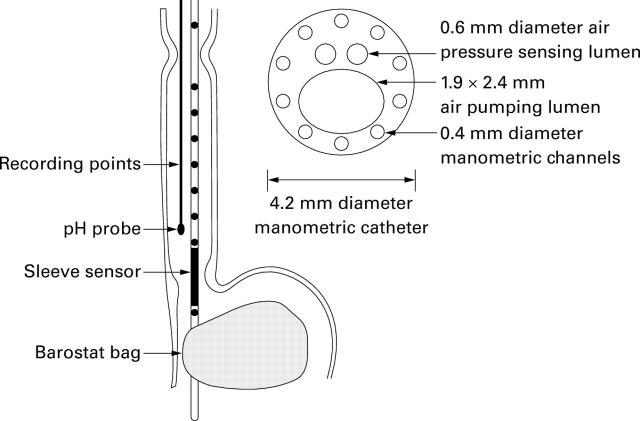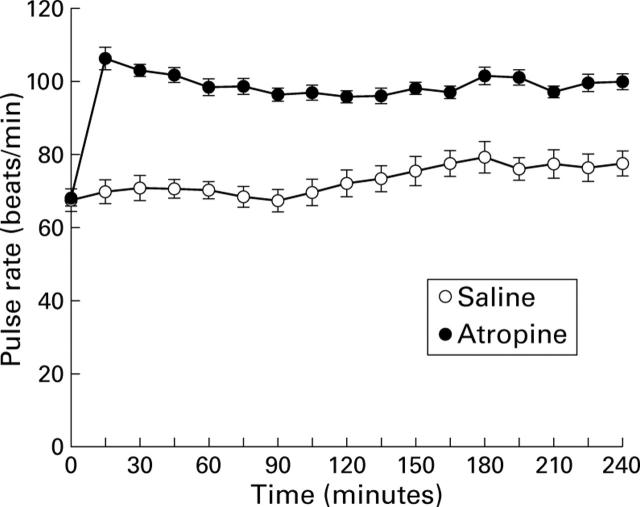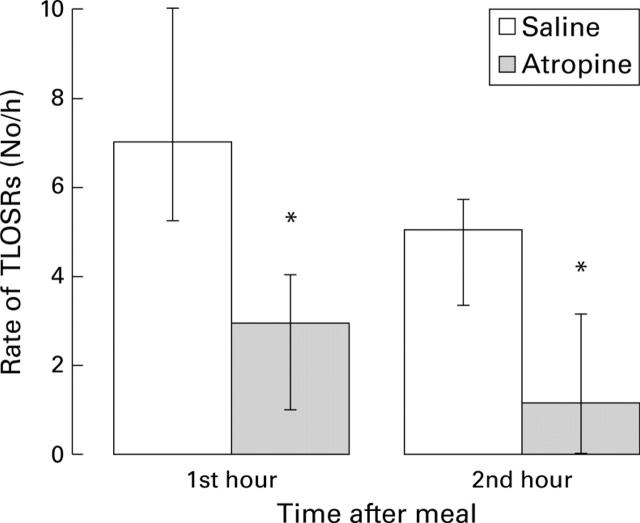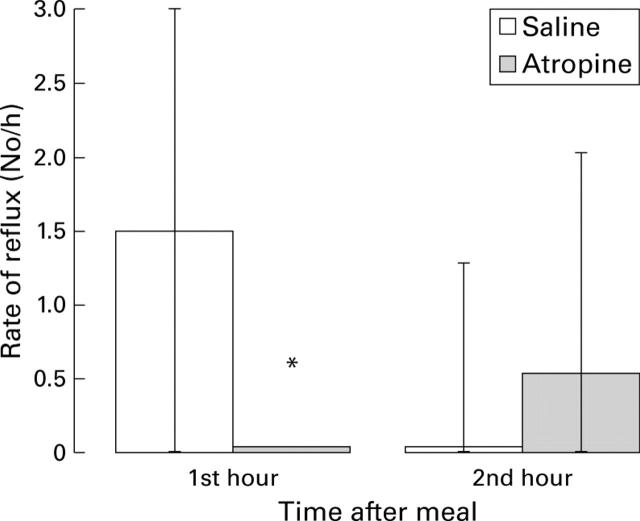Abstract
BACKGROUND AND AIMS—Distension of the proximal stomach is a major stimulus for triggering transient lower oesophageal sphincter (LOS) relaxations. We have shown recently that atropine inhibits triggering of transient LOS relaxations in both normal subjects and patients with gastro-oesophageal reflux disease. Atropine could potentially act centrally by inhibiting the central integrating mechanism in the brain stem, or act peripherally by altering the response of the stomach to distension. The aim of this study was to investigate the effect of atropine on fasting gastric compliance and postprandial gastric tone using an electronic barostat. METHODS—Fasting and postprandial proximal gastric motor and sensory functions were assessed in 10 normal healthy volunteers. Oesophageal manometry and pH were simultaneously measured. On separate days, atropine (15 µg/kg bolus, 4 µg/kg/h intravenous infusion) or saline was given and maintained for the duration of the recording period. RESULTS—In the fasting period, atropine significantly reduced minimum distending pressure (5.5 (0.4) v 4.4 (0.4) mm Hg; p<0.005) and increased proximal gastric compliance (81.3 (5.3) v 102.1 (8.7) ml/ mm Hg; p<0.05). In response to a meal, maximal gastric relaxation was similar on both study days. However, during atropine infusion, there was no recovery of proximal gastric tone in the two hour postprandial observation period. Postprandial fullness scores were higher during atropine infusion and correlated with changes in intrabag volume. Atropine significantly reduced the rate of postprandial transient LOS relaxations: first hour, 7.0 (5.3-10.0) v 3.0 (1.0-4.0) (p<0.02); second hour, 5.0 (3.3-5.8) per hour v 1.0 (0-3.0) per hour (p<0.05). CONCLUSIONS—In humans, fasting and postprandial proximal gastric motor function is under cholinergic control. Atropine induced inhibition of transient LOS relaxations is unlikely to be caused by its effect on the proximal stomach, but rather by a central action on the integrating mechanisms in the brain stem. Keywords: barostat; compliance; gastric fundus; atropine
Full Text
The Full Text of this article is available as a PDF (137.8 KB).
Figure 1 .
Diagrammatic illustration of the combined manometric and barostat assembly (left) and a cross sectional view of the assembly (right).
Figure 2 .
Effect of atropine or saline on heart rate for the duration of the infusion period . Data are expressed as mean (SEM).
Figure 3 .
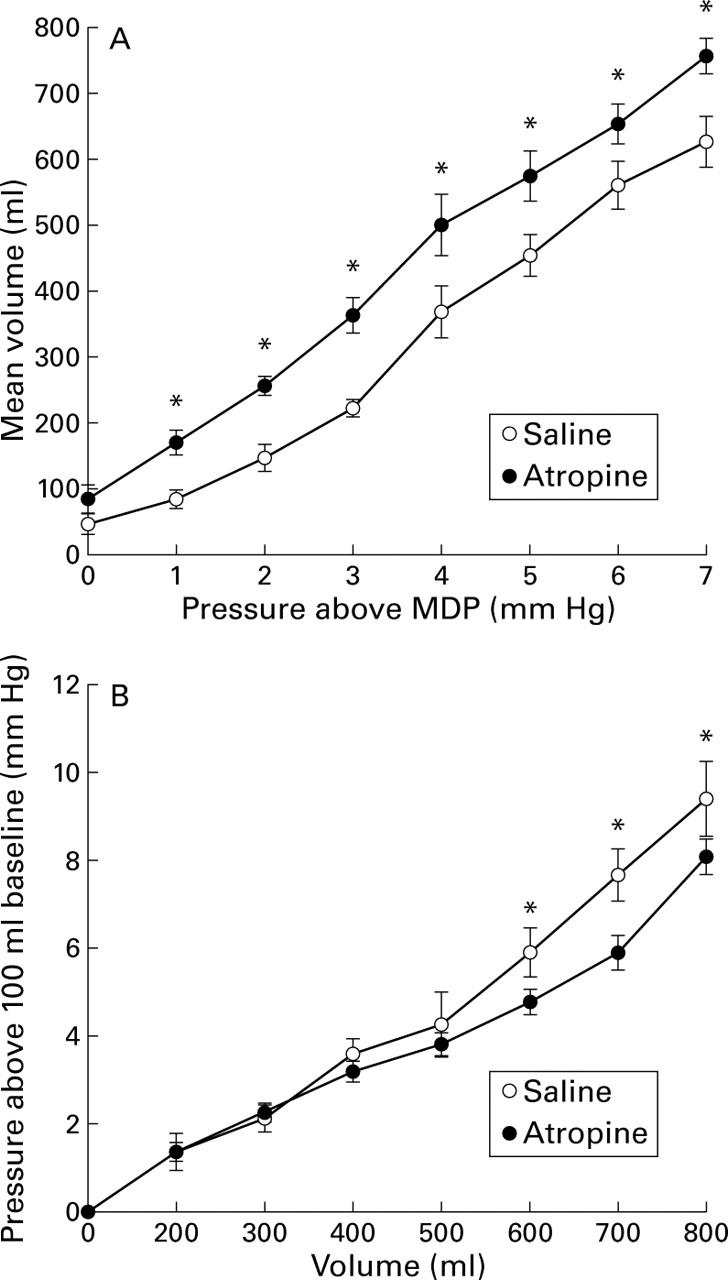
Effect of atropine on the pressure-volume relationship of the proximal stomach during pressure controlled (A) and volume controlled (B) distension. Data are expressed as mean (SEM). *p<0.05 v saline. MDP, minimum distending pressure.
Figure 4 .
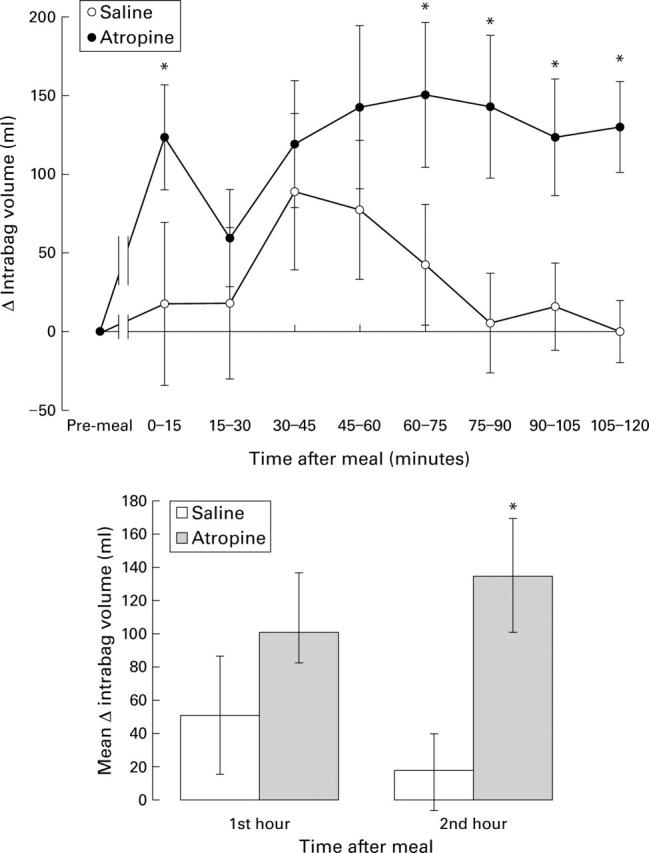
Effect of atropine on postprandial changes in proximal gastric volume. Data are expressed as mean (SEM). *p<0.05 v saline.
Figure 5 .
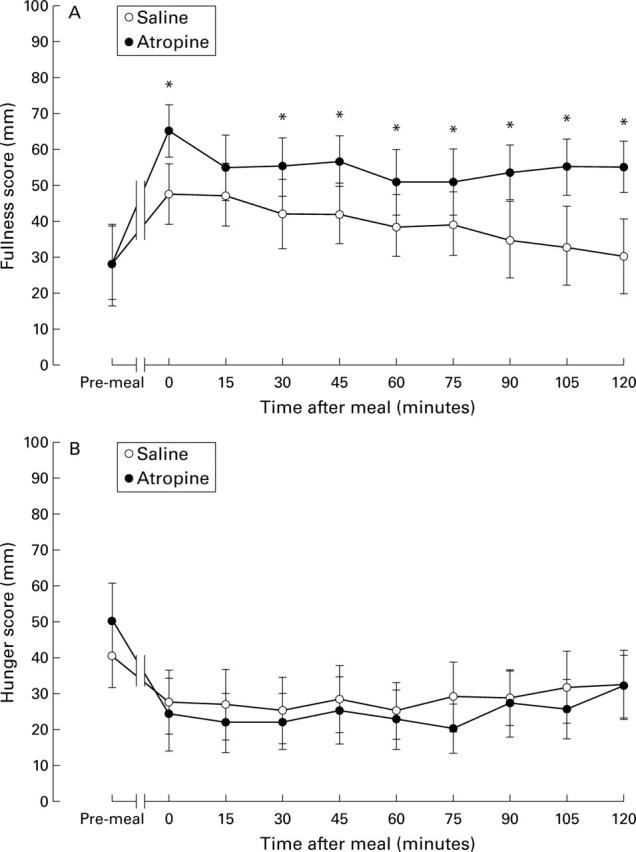
Effect of atropine on postprandial fullness (A) and hunger (B) scores. Data are expressed as mean (SEM). *p<0.05 v saline.
Figure 6 .
Effect of atropine on the number of transient lower oesophageal sphincter relaxations (TLOSRs). Data are expressed as median (interquartile range). *p<0.05 v saline.
Figure 7 .
Effect of atropine on the number of postprandial reflux episodes. Data are expressed as median (interquartile range). *p<0.05 v saline.
Selected References
These references are in PubMed. This may not be the complete list of references from this article.
- Azpiroz F., Malagelada J. R. Importance of vagal input in maintaining gastric tone in the dog. J Physiol. 1987 Mar;384:511–524. doi: 10.1113/jphysiol.1987.sp016467. [DOI] [PMC free article] [PubMed] [Google Scholar]
- Brann M. R., Ellis J., Jørgensen H., Hill-Eubanks D., Jones S. V. Muscarinic acetylcholine receptor subtypes: localization and structure/function. Prog Brain Res. 1993;98:121–127. doi: 10.1016/s0079-6123(08)62388-2. [DOI] [PubMed] [Google Scholar]
- Caulfield M. P. Muscarinic receptors--characterization, coupling and function. Pharmacol Ther. 1993 Jun;58(3):319–379. doi: 10.1016/0163-7258(93)90027-b. [DOI] [PubMed] [Google Scholar]
- Dent J., Dodds W. J., Friedman R. H., Sekiguchi T., Hogan W. J., Arndorfer R. C., Petrie D. J. Mechanism of gastroesophageal reflux in recumbent asymptomatic human subjects. J Clin Invest. 1980 Feb;65(2):256–267. doi: 10.1172/JCI109667. [DOI] [PMC free article] [PubMed] [Google Scholar]
- Dent J., Holloway R. H., Toouli J., Dodds W. J. Mechanisms of lower oesophageal sphincter incompetence in patients with symptomatic gastrooesophageal reflux. Gut. 1988 Aug;29(8):1020–1028. doi: 10.1136/gut.29.8.1020. [DOI] [PMC free article] [PubMed] [Google Scholar]
- Desai K. M., Sessa W. C., Vane J. R. Involvement of nitric oxide in the reflex relaxation of the stomach to accommodate food or fluid. Nature. 1991 Jun 6;351(6326):477–479. doi: 10.1038/351477a0. [DOI] [PubMed] [Google Scholar]
- Distrutti E., Azpiroz F., Soldevilla A., Malagelada J. R. Gastric wall tension determines perception of gastric distention. Gastroenterology. 1999 May;116(5):1035–1042. doi: 10.1016/s0016-5085(99)70006-5. [DOI] [PubMed] [Google Scholar]
- Dodds W. J., Dent J., Hogan W. J., Helm J. F., Hauser R., Patel G. K., Egide M. S. Mechanisms of gastroesophageal reflux in patients with reflux esophagitis. N Engl J Med. 1982 Dec 16;307(25):1547–1552. doi: 10.1056/NEJM198212163072503. [DOI] [PubMed] [Google Scholar]
- Franzi S. J., Martin C. J., Cox M. R., Dent J. Response of canine lower esophageal sphincter to gastric distension. Am J Physiol. 1990 Sep;259(3 Pt 1):G380–G385. doi: 10.1152/ajpgi.1990.259.3.G380. [DOI] [PubMed] [Google Scholar]
- Goyal R. K., Rattan S. Nature of the vagal inhibitory innervation to the lower esophageal sphincter. J Clin Invest. 1975 May;55(5):1119–1126. doi: 10.1172/JCI108013. [DOI] [PMC free article] [PubMed] [Google Scholar]
- Holloway R. H., Hongo M., Berger K., McCallum R. W. Gastric distention: a mechanism for postprandial gastroesophageal reflux. Gastroenterology. 1985 Oct;89(4):779–784. doi: 10.1016/0016-5085(85)90572-4. [DOI] [PubMed] [Google Scholar]
- Holloway R. H., Penagini R., Ireland A. C. Criteria for objective definition of transient lower esophageal sphincter relaxation. Am J Physiol. 1995 Jan;268(1 Pt 1):G128–G133. doi: 10.1152/ajpgi.1995.268.1.G128. [DOI] [PubMed] [Google Scholar]
- Horowitz M., Jones K., Edelbroek M. A., Smout A. J., Read N. W. The effect of posture on gastric emptying and intragastric distribution of oil and aqueous meal components and appetite. Gastroenterology. 1993 Aug;105(2):382–390. doi: 10.1016/0016-5085(93)90711-k. [DOI] [PubMed] [Google Scholar]
- Hould F. S., Cullen J. J., Kelly K. A. Influence of proximal gastric vagotomy on canine gastric motility and emptying. Surgery. 1994 Jul;116(1):83–89. [PubMed] [Google Scholar]
- Jahnberg T., Abrahamsson H., Jansson G., Martinson J. Gastric relaxatory response to feeding before and after vagotomy. Scand J Gastroenterol. 1977;12(2):225–228. doi: 10.1203/00006450-199404000-00024. [DOI] [PubMed] [Google Scholar]
- Levey A. I. Immunological localization of m1-m5 muscarinic acetylcholine receptors in peripheral tissues and brain. Life Sci. 1993;52(5-6):441–448. doi: 10.1016/0024-3205(93)90300-r. [DOI] [PubMed] [Google Scholar]
- Lidums I., Checklin H., Mittal R. K., Holloway R. H. Effect of atropine on gastro-oesophageal reflux and transient lower oesophageal sphincter relaxations in patients with gastro-oesophageal reflux disease. Gut. 1998 Jul;43(1):12–16. doi: 10.1136/gut.43.1.12. [DOI] [PMC free article] [PubMed] [Google Scholar]
- Mittal R. K., Chiareli C., Liu J., Holloway R. H., Dixon W., Jr Atropine inhibits gastric distension and pharyngeal receptor mediated lower oesophageal sphincter relaxation. Gut. 1997 Sep;41(3):285–290. doi: 10.1136/gut.41.3.285. [DOI] [PMC free article] [PubMed] [Google Scholar]
- Mittal R. K., Holloway R. H., Penagini R., Blackshaw L. A., Dent J. Transient lower esophageal sphincter relaxation. Gastroenterology. 1995 Aug;109(2):601–610. doi: 10.1016/0016-5085(95)90351-8. [DOI] [PubMed] [Google Scholar]
- Mittal R. K., Holloway R., Dent J. Effect of atropine on the frequency of reflux and transient lower esophageal sphincter relaxation in normal subjects. Gastroenterology. 1995 Nov;109(5):1547–1554. doi: 10.1016/0016-5085(95)90643-6. [DOI] [PubMed] [Google Scholar]
- Mittal R. K., McCallum R. W. Characteristics and frequency of transient relaxations of the lower esophageal sphincter in patients with reflux esophagitis. Gastroenterology. 1988 Sep;95(3):593–599. doi: 10.1016/s0016-5085(88)80003-9. [DOI] [PubMed] [Google Scholar]
- Notivol R., Coffin B., Azpiroz F., Mearin F., Serra J., Malagelada J. R. Gastric tone determines the sensitivity of the stomach to distention. Gastroenterology. 1995 Feb;108(2):330–336. doi: 10.1016/0016-5085(95)90057-8. [DOI] [PubMed] [Google Scholar]
- Parys V., Bruley des Varannes S., Ropert A., Rozé C., Galmiche J. P. Utilisation d'un barostat électronique pour la mesure de la réponse motrice de l'estomac proximal à l'alimentation et à différents stimuli nerveux chez l'homme. Gastroenterol Clin Biol. 1993;17(5):321–328. [PubMed] [Google Scholar]
- Penagini R., Schoeman M. N., Dent J., Tippett M. D., Holloway R. H. Motor events underlying gastro-oesophageal reflux in ambulant patients with reflux oesophagitis. Neurogastroenterol Motil. 1996 Jun;8(2):131–141. doi: 10.1111/j.1365-2982.1996.tb00253.x. [DOI] [PubMed] [Google Scholar]
- Ropert A., des Varannes S. B., Bizais Y., Rozé C., Galmiche J. P. Simultaneous assessment of liquid emptying and proximal gastric tone in humans. Gastroenterology. 1993 Sep;105(3):667–674. doi: 10.1016/0016-5085(93)90881-c. [DOI] [PubMed] [Google Scholar]
- Schoeman M. N., Tippett M. D., Akkermans L. M., Dent J., Holloway R. H. Mechanisms of gastroesophageal reflux in ambulant healthy human subjects. Gastroenterology. 1995 Jan;108(1):83–91. doi: 10.1016/0016-5085(95)90011-x. [DOI] [PubMed] [Google Scholar]
- Sifrim D., Holloway R. H., Tack J., Zelter A., Missotten T., Coulie B., Janssens J. Effect of sumatriptan, a 5HT1 agonist, on the frequency of transient lower esophageal sphincter relaxations and gastroesophageal reflux in healthy subjects. Am J Gastroenterol. 1999 Nov;94(11):3158–3164. doi: 10.1111/j.1572-0241.1999.01509.x. [DOI] [PubMed] [Google Scholar]
- Sivri B., Mittal R. K. Reverse-perfused sleeve: an improved device for measurement of sphincteric function of the crural diaphragm. Gastroenterology. 1991 Oct;101(4):962–969. doi: 10.1016/0016-5085(91)90722-w. [DOI] [PubMed] [Google Scholar]



